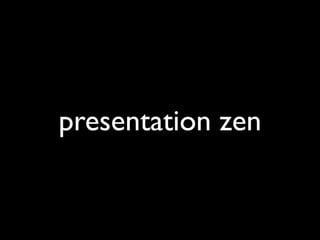
Presentation Zen
- 8. easy to see
- 9. Larry Lessig
- 14. Dick Hardt @ OSCON 2005
- 17. Guy Kawasaki
- 18. The Kawasaki Method
- 19. top 10 format
- 20. 10 slides 10 major ideas
- 21. 10/20/30 rule
- 22. 10 slides
- 23. 20 minutes
- 24. 30 point font
- 25. (minimum)
- 26. a contrast in styles
- 27. Steve Jobs
- 29. Bill Gates
- 35. what can we learn?
- 36. top 10 list
- 37. (10)
- 38. have a clear goal...
- 42. (9)
- 43. slides are a visual aid
- 44. slides are not the main event...
- 45. you are the main event.
- 46. (8)
- 48. context matters
- 49. not “good” or “bad”
- 50. “appropriate” (or not)
- 51. (7)
- 52. be “open”
- 53. body language matters
- 54. attitude matters
- 55. connect with the audience
- 58. (6)
- 60. pauses are good
- 61. (5)
- 62. simple...
- 63. (no more than 6 to 10 words per slide)
- 65. bullet points are bad
- 66. m’kay
- 67. focus on clarity
- 68. (4)
- 69. use notes...
- 70. ...but don’t use your slides as notes.
- 71. (3)
- 72. there is no #3
- 73. (humor is good)
- 74. (2)
- 75. powerpoint is not good for...
- 77. ...lots of words
- 78. ...inspiring an audience.
- 79. (1)
- 80. DON’T
- 81. USE
- 82. BULLET POINTS!
- 83. (‘nuff said)
- 84. (0)
- 85. there are no rules
- 86. Remember...
- 87. only you can prevent bad presentations.
- 88. Resources
- 89. Edward R. Tufte
- 90. The Cognitive Style of Powerpoint
- 93. finis
Notas do Editor
- Good afternoon and welcome to “Presentation Zen”. I am Phil Toland I work in IT on Customer Portal I will be giving today’s Lunch and Learn presentation
- This is a presentation about presentations A “meta presentation” I will talk about using slideware as a communication tool I will not talk about how to create a presentation in powerpoint
- Bad presentation anecdote: Vendor presentation Presenter did not know the subject matter, was reading slides “I don’t know what this slide is trying to say”, “I think this slide is trying to say...” Typical of bad presentations, we left the room annoyed with the vendor
- We will start out by looking at some new and different presentation styles Different ways to approach the problem Mine for inspiration and ideas
- Takahashi is a developer who was asked to give a five minute presentation He didn’t have powerpoint or graphics software, yet he wanted to make a good impression He decided to put a few carefully chosen characters on the screen for each slide
- This style is known as the Takahashi Method The characters on the screen are carefully chosen to have the most impact Overlap of written language and art
- Uses very large fonts A few characters take up the whole screen Audience doesn’t have to spend a long time looking at the screen to understand
- The large characters are easy to see from all points in the room The simplicity of the slide does not distract from the speaker
- Larry Lessig, attorney and law professor at Stanford Involved with the EFF and created the Creative Commons Advocate for “free culture” and copyright reforms
- Similar to the Takahashi method
- Lessig’s slides often contain a single word
- quote
- or photo
- Best example of Lessig Method was keynote given by Dick Hardt at OSCON 2005 We are going to watch the first three minutes
- Hardt made good use of animations, they were subtle Pacing was good but difficult to maintain Requires lots of planning Talk was only 15 minutes long
- Guy Kawasaki, venture capitalist Gives a lot of presentations Listens to a lot of business pitches
- Tired of boring presentations Top 10 format gives some idea of progress Kawasaki uses top 10 for all of his presentations
- 10 slides 10 major ideas helps keep things simple
- Kawasaki’s advice to people pitching business ideas to him the 10/20/30 rule Extension of top 10 format
- Gives time for question and answer Padding for, eg projector failure People show up late and leave early
- Easy to see c.f. Takahashi method
- fonts should probably be much bigger I use 96pt in this presentation
- Look at two very different presentation styles Consider the styles, not the individual presenting or the company they represent
- Very dynamic and open style Known for his ability to hold an audience Every “Stevenote” is sold out
- Simple...three main elements Immediately clear A prop, not the main message
- Is that litter? Too many different colors Information overload
- Simple graphic Supports what Steve is saying Doesn’t take attention away from Steve
- Takes attention away from Bill Too much...doesn’t support a single point well Is it raining on the iMac?
- Steve is comfortable with himself on stage Comes out close to the audience Uses blank screen to focus attention on himself
- Bullet points as a crutch Bill is not as comfortable...nervous gesture of bringing hands together Stays back from the audience At least move each bullet point to a different slide
- These are all examples to be learned from
- Advice from Edward Tufte...
- Edward Tufte “Never apologize. If you’re worried the presentation won’t go well, keep it to yourself and give it your best shot. Besides, people are usually too preoccupied with their own problems to notice yours.“
- Edward Tufte: “Be sure to allow long pauses for questions.”